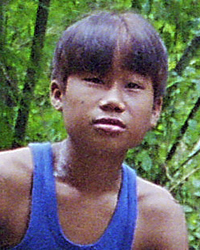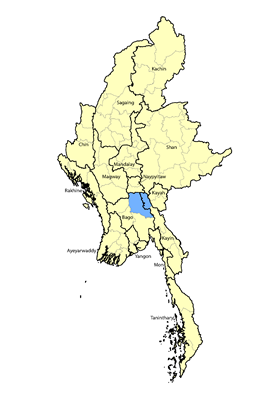Although they accept that they are part of the larger Karen ethnicity, the Mobwa have their own customs and language, and the Karen political leadership has viewed them as a distinct subgroup in recent decades. In some locations, the Mobwa live in mixed communities alongside Bwe and Paku Karen people. They appear to be most closely related in lifestyle and culture to the Bwe Karen.
Location: With a modest population of 4,600 people, the Mobwa Karen are distributed in nine villages at the western end of the foot of the Thandaung mountains in Kayin State's Thandaunggyi Township. Kayin, formerly known as Karen State, runs along the Thailand border in eastern Myanmar. Smaller numbers of Mobwa Karen live in Taungoo (“spur of the hill”) Township in the Bago Region.
Language: Part of the Southern Karenic branch of Tibeto-Burman, Mobwa is most like Paku Karen and has been classified by linguists as “threatened.” While all Mobwa adults can speak their language, a growing number of young people prefer to speak Burmese and S'gaw Karen. Mobwa has not been reduced to a written form, so promoting its use by teaching it to new generations is problematic.
When the British took control of Burma, they were challenged with how to subdue the many Karen tribes. In 1863, the finance commissioner of Lower Burma, Donald Smeaton, wrote: “Nearly the whole of the Karen tribes on the mountains east of Taungoo were in a savage state. The Burmese never had authority over any of the tribes living more than a day's journey from the city and river.”
In many Karen locations in this part of Myanmar, the terrain is almost impenetrable, with dense jungles filling in the valleys between towering mountains. To tame the land, elephants have long been used in much the same way that bulldozers are used in the developed world, leveling the land and transporting timber and other heavy objects to new places. Many Mobwa Karen continue to live as they have for centuries, feeding their families by growing crops and hunting. The Karen New Year is an important occasion for all Karen. Thandaunggyi is one of the main locations where Karen people from various tribes come together to celebrate.
The British official, Smeaton, went on to explain that the Christian conversion of tribes in Taungoo, including the Mobwa, totally changed their societies: “In process of time, from the constant labor of the missionaries, many thousands of the mountain Karens were instructed to Christianity, abandoned their savage mode of life and their cruel wars, and lived as Christian men and women…. I assert that such results could not be obtained by the civil administration if unaided by missionary teaching.”
Catholic missionaries, spearheaded by Bishop Eugenio Biffi from Colombia in South America, began working among the Karen tribes in Taungoo in 1868. They encountered immediate success, and just four years later Taungoo was made a Prefecture Apostolic. American Baptist missionaries also worked in the area, and today all Mobwa Karen people are professing Christians. Thandaunggyi is home to the Nawbubaw Prayer Mountain, which is adorned with a large iron cross. The main, boat-shaped hall has many small prayer rooms around it. The facility is reached by ascending 374 steps to the top of the hill, which affords breathtaking views of the surrounding countryside.4 Despite their long-held belief in the Gospel, no Scripture or any other resources have ever been translated into Mobwa, which has probably stunted their spiritual growth. Lacking the Bible in their own heart language, the Mobwa Christians have long used the S'gaw Karen Bible, which was first published in 1853.
Scripture Prayers for the Karen, Mobwa in Myanmar (Burma).
| Profile Source: Asia Harvest |











